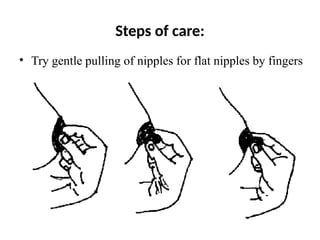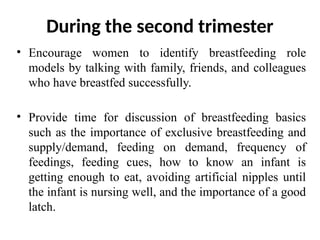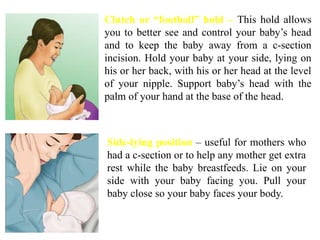Breast care during_pregnancy
- 1. Breast care during pregnancy Radhika Chintamani
- 2. Introduction • Special care of the breasts during pregnancy is an important preparation for breastfeeding. • Changes to the breasts are one of the early signs of pregnancy • During antenatal period, the breasts often have a feeling of fullness and become larger, heavier, and more pendulous because of the stretching of the cooper’s ligament that supports the breast
- 3. • Many women feel a change in sensation in their breasts such as tingling and soreness (particularly of the nipples). • This is due to increased levels of the hormone progesterone and the development of the milk ducts. • As pregnancy progresses the nipples and areola become darker in color and the veins on the surface of the breast may become more noticeable. • The Montgomery glands get bigger and can become more noticeable.
- 4. • From about 16 weeks of pregnancy the breasts are able to produce milk (colostrum) • In the last few weeks of pregnancy the nipples become larger and the breasts continue to expand as the milk-producing cells get bigger. • A few women may have occasional leakage of blood from the nipple. This is due to the increased number and sudden growth of blood vessels
- 5. • Antenatal preparation of pregnant women for breastfeeding raises awareness of the importance of breastfeeding, empowers them with practical knowledge and skills in breastfeeding techniques, and prepares them for possible difficulties. • Proper education of mother and relatives is possible and mandatory during pregnancy. Flat or inverted nipple can lead to difficulties in breastfeeding for the child. Hence, during pregnancy women can become aware of it & take necessary steps.
- 6. • Some studies have demonstrated that the use of soap, alcohol, and other such materials during the antenatal period tends to be detrimental to the integrity of the nipple tissue because they remove the protective skin oils and leave the nipple more prone to damage. • Cleanliness of the breasts is important, especially as the woman begins producing colostrum.
- 7. • Every pregnant woman should wear a well-fitted brassiere to support the breasts in a normal uplifted position. • Proper support of the breasts is conducive to good posture and thus helps to prevent backache
- 8. Problems with Breast Feeding • Flat Nipple • Inverted Nipple • Protruded nipple • Nipple Soreness • Heaviness of breast
- 9. CARE OF FLAT AND INVERTED NIPPLES • Nipples can be flat, normal, long or inverted (nipples cannot be gripped easily postnatal). Long Normal Flat Inverted
- 10. Steps of care: • Try gentle pulling of nipples for flat nipples by fingers
- 12. • Make a “C” shape with your right hand. • Place your thumb and first finger around the areola. • Push back against your chest. • Gently squeeze the thumb and finger together. • Use a mirror to look at a side view of both nipples as you do the pinch test. • A normal nipple will move forward. • Flat or inverted nipples move back and may cause problems with breastfeeding.
- 13. • A 10 ml syringe at the front. end, remove the plunger from hind end and insert it from the cut front end. • Then press open hind end of the syringe lightly over the areola covering the nipple and withdraw the plunger (which is now at the front cut end) so that the nipple is pulled into the syringe. • Maintain pull for 20 to 30 seconds and then release. Gently remove the syringe. Nipple will remain protruded. Then put the child for breastfeeding.
- 14. • Use “Nipple Shell” (hard plastic shell with holes worn over nipples) for flat and inverted nipples. • If not available in the market, make it at home from wood, plastic or cap of feeding bottle. • Remember, to make it with smooth margins So file all sharp margins, as there can be injurious.
- 15. During the first trimester • Incorporate and educate partners, parents, and friends about the benefits of breastfeeding for mothers and babies. • Address known common barriers such as lack of self- confidence, embarrassment, time and social constraints, dietary and health concerns, lack of social support, employment and child care concerns, and fear of pain.
- 16. During the second trimester • Encourage women to identify breastfeeding role models by talking with family, friends, and colleagues who have breastfed successfully. • Provide time for discussion of breastfeeding basics such as the importance of exclusive breastfeeding and supply/demand, feeding on demand, frequency of feedings, feeding cues, how to know an infant is getting enough to eat, avoiding artificial nipples until the infant is nursing well, and the importance of a good latch.
- 18. During the third trimester • Demonstrate how to hold the breast and positions of the baby such as cradle, cross- cradle, and the clutch hold • Repeat the breast and nipple examination • Recommend the purchase of properly fitting nursing brasseries
- 19. Antenatal Interventions • For decades, mothers were taught antenatal nipple conditioning techniques in the hope of preventing sore nipples Nipple rolling Rubbing with terry cloth towel Hoffman’s exercises (areolar stretching) Avoidance of soap on nipples Masse cream or other ointments Air exposure under clothing
- 20. Treatment of inverted nipples • The use of breast shells is often suggested for inverted nipples. The shells are worn in the brassier and apply gentle pressure around the base of the nipple to stretch the adhesions. • Gently compressing the areola about an inch (2.5 cm) behind the base of the nipple.
- 21. • Even the pregnant woman can use a device called the Niplette - mechanically stretch the shortened internal tissues. • Supple Cup has been used for prenatal eversion of flat nipples • Supple Cups are small thimble-like silicone cups that are squeezed to evacuate the air, placed over the nipple and released to create a vacuum that exerts traction on the nipple.
- 23. Antenatal expression of colostrum • Colostrum is a thick yellow-colored substance and is very rich in immune-promoting proteins • The antenatal expression of colostrum is becoming more common. • From about the 16th week of pregnancy, a mother’s breasts begin to make colostrum.
- 24. Antenatal Banking of Colostrum • Benefits of expressing and banking colostrum Helps to stabilize baby's blood glucose levels in the newborn period to prevent hypoglycemia and neurological complications Reduces artificial milk (formula) being offered to baby after birth if you have chosen to breast feed Helps develop the skill of hand expressing breast milk which continues to be useful
- 25. POINTS TO REMEMBERED DURING PREGNANCY • Put the baby to breast immediately after delivery and allow it to suck for 10 to 15 minutes. • Colostrum (initial breast milk), should be given to the baby as it is nutritious and protects against diseases. • Give nothing except breastfeeding. • Allow child to suckle 8 to 10 times a day even if breast milk is less. • Breastfeeding decreases bleeding from uterus and helps to decrease its size faster.
- 26. • Breast milk is the best food for the new born. Its quality remains high unless mother is taking certain drugs for her serious disease. • Do not start bottle-feeding as it causes “nipple confusion” and the baby thereby gets used to bottle, as it requires no effort in comparison to breastfeeding.
- 27. • Do not use pacifiers or artificial nipples. • Ability to breastfed does not depend on size of breast. • Mothers should always keep confidence in breastfeeding. It solves all the problems. • There is no other milk as a complete substitute to breast milk.
- 28. Breastfeeding Education • Prenatal breastfeeding education includes the following: • Guidance for mothers about anticipated situations and signs of effective breastfeeding or breastfeeding problems. • The benefits of breastfeeding to mother, baby, and society. • Correct positioning to help the infant latch onto the breast effectively. • Specific needs in the early days of breastfeeding. • Common fears, concerns, problems, and myths.
- 29. Breast feeding Holds Cradle hold – an easy, common hold that is comfortable for most mothers and babies. Hold your baby with his or her head on your forearm and his or her whole body facing yours. Cross cradle or transitional hold – Hold your baby along the opposite arm from the breast you are using. Support your baby’s head with the palm of your hand at the base of his or her neck.
- 30. Clutch or “football” hold – This hold allows you to better see and control your baby’s head and to keep the baby away from a c-section incision. Hold your baby at your side, lying on his or her back, with his or her head at the level of your nipple. Support baby’s head with the palm of your hand at the base of the head. Side-lying position – useful for mothers who had a c-section or to help any mother get extra rest while the baby breastfeeds. Lie on your side with your baby facing you. Pull your baby close so your baby faces your body.
- 31. The benefit to the infant • Human milk is species specific, it offers ideal nutrition, protein and fat content is suited to the needs of the infant and provide protection against iron and vitamin deficiency. • Breast milk contains over 100 biologically active ingredients. It offers immunological protection to an infant. Protects from various diseases.
- 32. Cont.. • Breast feeding provides a close interaction between mother and infant and helps to develop a strong, positive, emotional bond which has long –term psychological advantages. • Action of breast feeding facilitates correct jaw and dental development and the incidence of sudden infant death is lower in breast infants.
- 33. The benefit to the mother • Psychological satisfaction and close maternal bonding with her infant • Exclusive breast feeding associated with lactational amennohea is an effective, reliable method of birth control and child spacing • Prolonged breast feeding reduces the risks of premenopausal breast cancer and ovarian cancer. • It reduces the post partum anemia.
- 34. THANK YOU

































